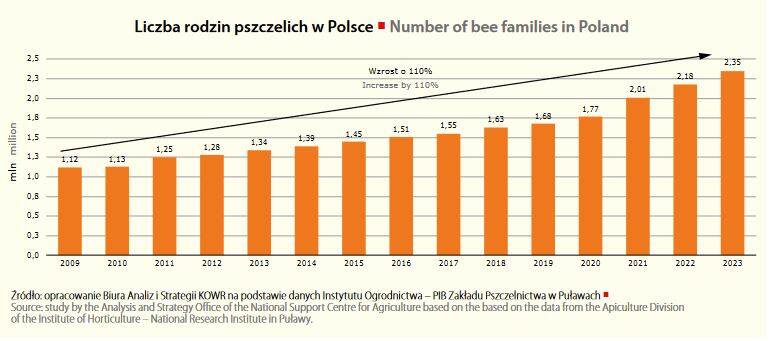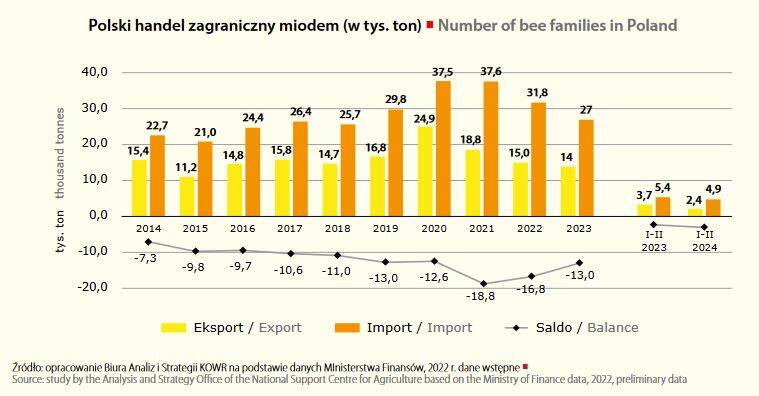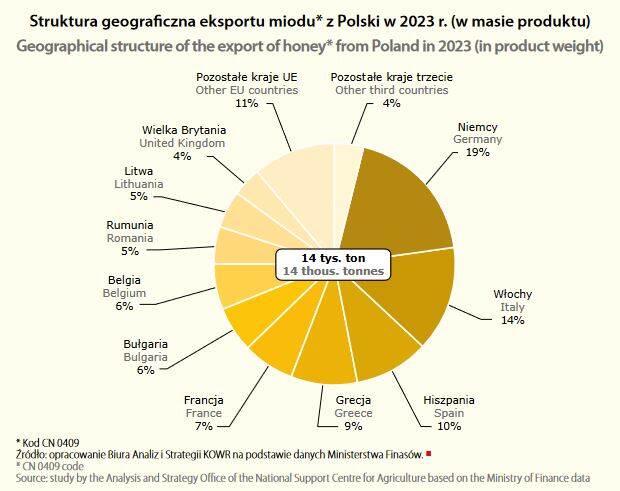Polish honey market
Beekeeping is the type of agricultural production which goes beyond the honey production. Honey is an excellent dietary and therapeutic product and honeybees play a key role as pollinators of plants.

Apart from honey, bee products include: royal jelly, wax, bee venom, pollen, bee bread and propolis. Bee products are used in the food, pharmaceutical and cosmetic industries. Honeys and bee products produced in Poland are characterized by their high quality, which is essential in competing with imported honeys.
Development of the sector
In Poland, beekeeping is conducted mainly on small family farms. The regular increase in the number of bee families and the growing interest in running a beekeeping farm does not translate into a long term increase in the production of honey in Poland, which is largely dependent on weather conditions in the spring and the health of bees.
A positive effect of the support programmes being implemented is the growing number of bee families in Poland. In 2023, there were about 2.35 million bee families in Poland, by 8% more than in 2022 and more than twice as many as in 2009.

The production of honey in Poland in figures
The largest number of bee families (beehives) in 2023 were located in the Lubelskie Voivodeship (13% of all families), and the smallest in the Opolskie Voivodeship (3%). The largest beekeeping farms were located in the Warmińsko-Mazurskie Voivodeship (on average, 41 hives), Zachodniopomorskie Voivodeship (31 hives), Lubelskie Voivodeship (30 hives) and Lubuskie Voivodeship (28 hives). However, the smallest apiaries were located in the Śląskie Voivodeship (14 hives) as well as in the Małopolskie, Łódzkie and Opolskie Voivodeships (about 21 hives each).
In the last decade, the honey harvest in Poland was very diverse and ranged from nearly 13 to over 24 thousand tonnes (based on the data from the Apiculture Division of the Institute of Horticulture – NRI). The volume of the honey harvest depended, first of all, on weather conditions affecting the beginning of the flowering period of plants in a given year and on the condition of bees after the winter period.

Import of honey
Poland is a net importer of honey, which results from the insufficient supply from domestic production in relation to the demand of the internal market. In the years 2014–2023, Poland imported from 21 thousand tonnes of honey in 2015 to nearly 38 thousand tonnes in 2021. The level of the import of honey to Poland in the last three years has shown a downward trend.
In 2023, the import of honey was by 15% lower than in 2022 and amounted to about 27 thousand tonnes. The lower import volume in 2023 probably resulted from the higher domestic production.
Just like in previous years, honey was imported to Poland mainly from China and Ukraine. In 2023, 14.2 thousand tonnes of honey were imported from China (which accounted for about 52% of the total import volume), while from the Ukrainian market 9.6 thousand tonnes of honey were imported to Poland (36% of the share in import).

Export of honey
Poland is also an exporter of honey. In the years 2014–2023, domestic entrepreneurs sold abroad from 11 to nearly 25 thousand tonnes of honey a year. In 2023, Poland exported nearly 14 thousand tonnes of honey when compared to 15 thousand tonnes in 2022. Just like in previous years, in 2023, the main customer of honey from Poland were the European Union countries, to which slightly more than 90% of the export volume were sent. The largest EU customers of honey from Poland were Germany (2.7 thousand tonnes), Italy (1.9 thousand tonnes), as well as Spain and Greece (1.4 thousand tonnes and 1.3 thousand tonnes, respectively).
Honey with the “Polish Product” Designation Beekeepers, food producers and distributors of honey and bee products should use the “Polish Product” designation as often as possible. It is important for consumers who treat the country of origin as one of the criteria for selecting agri-food products, including honeys and other bee products.

Source: Polish Food